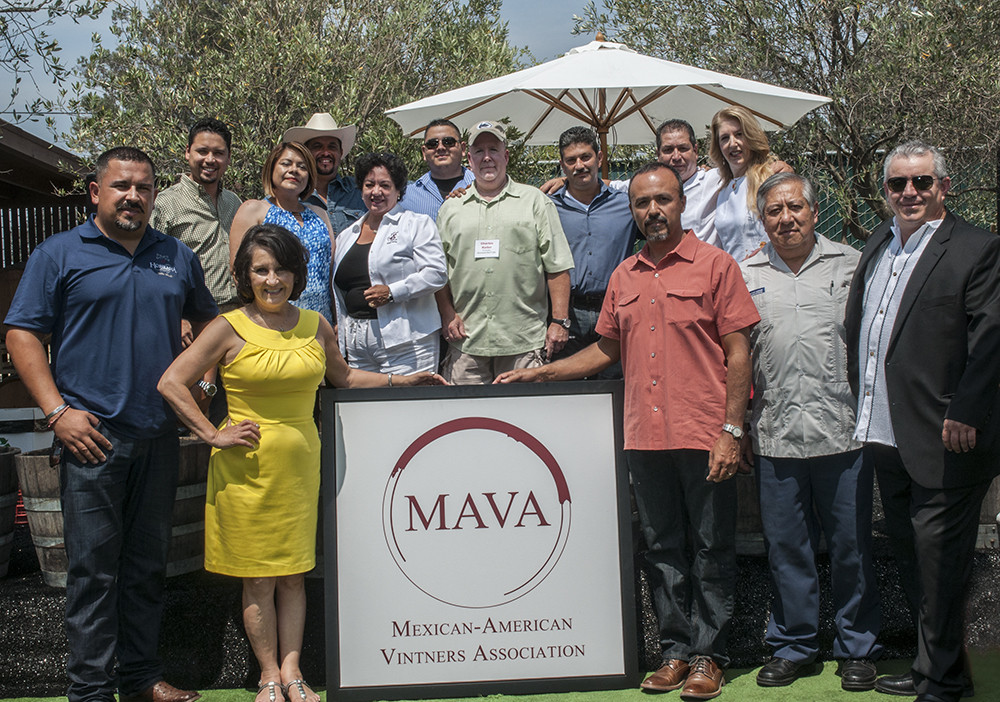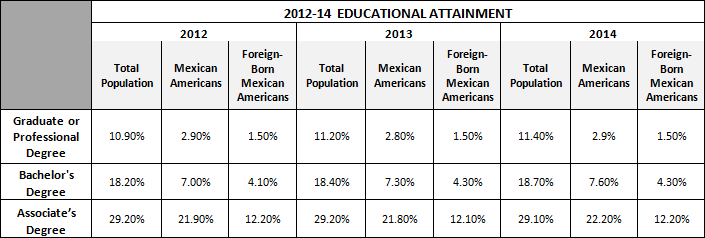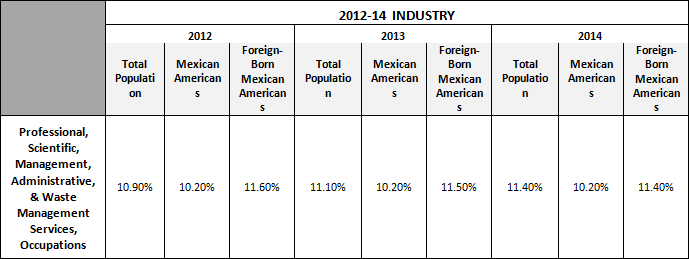

Religion, Race/Ethnicity, and Norms of Intergenerational Assistance among Older Adults
CG Ellison, X Xu – Religions, 2015
… Results indicate that African Americans and Hispanics tend to express stronger support for
intergenerational assistance than non-Hispanic Whites. … Keywords: religion; race; African
Americans; Latinos; aging; intergenerational assistance 1. Introduction …
Link to article
Mexico Stubbornly Resists Accountability
When he campaigned for the presidency of Mexico, Enrique Peña Nieto used the title of his book, “Mexico, the Great Hope,” to explain the record he hoped to achieve and the nation he hoped to build. More than three years into his presidency, it seems more likely that he will be remembered not as the transformational leader Mexicans thought they had elected, but as a politician who skirted accountability at every turn…
Link to Editorial Opinion
Student Faculty Interactions: Understanding Mexican American Community College Students
G Román – 2015
… Figure 1. shows that Mexican Americans are the largest subgroup from the entire
Latina@ population and their numbers are expected to grow in the coming years
(Motel and Patten 2012). The reason why this is important is …
Link to article”
All for One? And One for All? Mexican American Group Consciousness and Partnership
JL Urbano Jr – Minority Voting in the United States [2 volumes], 2015 – books.google.com
Latinos are the largest minority group in the United States, and within this pan-ethnic group
are Mexican Americans who constitute over 66 percent of the total Latino population.
Because of its current size and future population estimates, experts frequently speculate …
Link to book
The Perceptions, Knowledge , Benefits and Barriers of Hispanics Regarding the Dietary Guidelines for Americans
LDA Gamboa – 2015
… 2005). However, the San Antonio Heart Study contradicted this paradox, showing
that Mexican- Americans indeed had a higher risk of cardiovascular and coronary
diseases than did non-Hispanic Whites (Hunt et al., 2003). …
Link to thesis
Grounds for Dreaming: Mexican Americans, Immigrant Mexicans, and the California Farmworker Movement
LA Flores – 2016 – books.google.com
Known as “The Salad Bowl of the World,” California’s Salinas Valley became an agricultural
empire due to the toil of diverse farmworkers, including Latinos. A sweeping critical history of
how Mexican Americans and Mexican immigrants organized for their rights in the decades …
Link to book preview
Immigrants and Gender Roles: Assimilation vs. Culture
FD Blau – 2015
Page 1. NBER WORKING PAPER SERIES IMMIGRANTS AND GENDER ROLES:
ASSIMILATION VS. CULTURE Francine D. Blau Working Paper 21756
http://www.nber.org/papers/w21756 NATIONAL BUREAU OF ECONOMIC …
Link to paper
Digging for a Tale: Genomic Analysis Solves Mysteries Surrounding America’s Earliest People
T Tanenbaum
… and her colleagues undertook genetics as well as morphological analyses on historical Mexican
and South American populations, the latter to re-evaluate whether these ancient skulls were closer
in skull morphology to Australo-Melanesians than to modern Native Americans. …
Link to article
The American Middle Class Is Losing Ground
After more than four decades of serving as the nation’s economic majority, the American middle class is now matched in number by those in the economic tiers above and below it. In early 2015, 120.8 million adults were in middle-income households, compared with 121.3 million in lower- and upper-income households combined, a demographic shift that could signal a tipping point, according to a new Pew Research Center analysis of government data…
Link to article
Latino/a Immigration: A Refutation of the Social Trust Argument
JJ Mendoza – 2015
… There is no Americano dream. There is only the American dream created by an
Anglo-Protestant society. Mexican-Americans will share in that dream and in that
society only if they dream in English. (Huntington 2004, 256) …
Link to chapter
From Undocumented to Goldman Sachs Exec: Julissa Arce’s Amazing Story
NEW YORK, NY — A job at the investment bank Goldman Sachs is one of the most prized positions in the country. The company prides itself on attracting some of America’s most talented professionals—ambitious, smart and highly motivated. Many people would probably be very surprised to discover that at least one undocumented Mexican immigrant was working shoulder to shoulder with the country’s corporate elite.
Former Goldman Sachs vice president Julissa Arce, 32, wants to change the way Americans think about immigration by sharing her story. And in her upcoming September 2016 memoir, “My (Underground) American Dream,” she aims to describe her long and difficult journey from undocumented to documented, which took her from selling funnel cakes in Texas to Wall Street…
Link to article
Poll: 49% of Americans say racism is a ‘big problem’
(CNN) Debra Aust sees it in videos of recent police shootings.
Alex Sproul reads about it in his Facebook feed.
Sheryl Sims senses it when she walks down the street.
They are three Americans from three different demographic groups living in three different states. And they believe the same thing: Racism is a big problem.
Their voices are just a few in a country of more than 322 million people. But they are far from alone…
Link to article
More Mexicans Leaving Than Coming to the U.S.
More Mexican immigrants have returned to Mexico from the U.S. than have migrated here since the end of the Great Recession, according to a new Pew Research Center analysis of newly available government data from both countries. The same data sources also show the overall flow of Mexican immigrants between the two countries is at its smallest since the 1990s, mostly due to a drop in the number of Mexican immigrants coming to the U.S…
Link to article
Hidden in Plain Sight: A Note on Legitimation Crises and the Racial Order
MC Dawson – 2015
… that have conflicting interests and ideologies. Blacks and Latinos (particularly Mexican Americans,
who have been targets of increasingly vile and racist anti-immigrant attacks), are becoming
increasingly disillusioned and angry due to the escalation of white supremacy within …
Link to article
Felix Arroyo’s Journey Through Public Education to Housing the Homeless
Growing up in Boston Public Schools, Felix Arroyo got to know the University of Massachusetts Boston through the Talented and Gifted (TAG) Latino Program, a program for young English language learners.
“In middle school I was running around those hallways at UMass Boston,” he says. “I’m looking forward to being a partner with UMass in my role now, while I have it, to make sure that the school is successful.”…
Link to article
The Power of Zero
Fifty years after founding the influential theatre company, El Teatro Campesino, Luis Valdez visited USF last Tuesday to give a lecture called “The Power of Zero.” The talk focused primarily on the connection between the Mayan zero and the influence it holds on different aspects of life, especially its capacity to allow for change. Being at ground zero holds great potential and is the root of development, which Valdez related to the Chicano movement…
Link to article
From the Delano Grape Strike to the Mexican American Vintners Association
By Humberto Gutierrez

There have been several longitudinal studies on Mexican American mobility showing that although the monetary movement of Mexican Americans is not quite as rapid as that of whites, there is still a steady accumulation of wealth across generations.
This mobility is evidenced by the progress made by Mexican American professionals. As evidence of this success, we have witnessed the birth of several prominent professional associations. Most notable are:
- MAES, Latinos in Science and Engineering
- AMAE, Association of Mexican American Educators
- MABA, Mexican American Bar Association
- SACNAS, Society for Advancement of Chicanos and Native Americans in Science
- MAHPA, Mexican American Hispanic Physicians Association
- MABPA, Mexican American Business and Professional Association
- MALFA, Mexican American Latino Faculty Association
- MAVA, Mexican American Vintners Association
The latest American Community Survey shows year-to-year progress, or lack of it, on the survey’s annual census.
Prominent among this year is the continued progress of Mexican American college enrollment, which has jumped from 18.1% in 2013 to 18.7% in 2014. Unfortunately, graduate or professional degrees remain low with a small gain. For 2013, the graduate or professional degree was 11.2% and for 2014 this percentage climbed to 11.4% for the total population, while for 2013 it was 2.8% for Mexican Americans, and 2.9% for 2014.


Occupations in management, business, science, and arts showed a nice increase for Mexican Americans, from 16.7% to 17.4% while for the total population percentages went from 36.3% in 2013 to 36.9% in 2014. Mexican Americans still lag far behind the total population but there is a slight gain as compared to the total population.

For industry, numbers have gone up slightly for the total population but have remained stagnant for Mexican Americans.

References
- Census Bureau, Selected Population Profile in the United States: 2014
- United States S0201 and B05006. Selected Population Profile in the United States
- Population Groups: Mexican and Mexico (foreign-born)
- Data Set: American Community Survey 1-Year Estimates for years 2012 and 2014
- Census Bureau, American Fact Finder, Selected Population Profile in the United States
MEXICAN-AMERICAN WOMEN AND ABORTION: EXPERIENCES AND REFLECTIONS
LB Welter – 2015
… for Meaning-making …..122 and Guidance …..122 Theme 3. Mexican-American Cultural Values …
215 Positive Outcomes from Abortion …..219 Expanded Academic, Professional, and Financial …
Link to dissertation
Conceptualizing Interpersonal Relationships in the Cultural Contexts of Individualism and Collectivism
CRPM Greenfield, B Quiroz
… There werc fifteen teachers from this school, including-eleven European Americans, two African
Amer- icans, and two Mexican Americans [one was born in the United States. and one had
immigrated thirteen years before). School “2 was an urban public school. …
Link to article
From Factory To Classroom: A Worker, A Student — And A Mother
Today, Noramay Cadena is a mechanical engineer, fitted with multiple degrees from the Massachusetts Institute of Technology. But she came by her motivation in a place much different from the MIT classrooms: a factory in Los Angeles where her mother brought her one summer as a teenager…
Link to article


